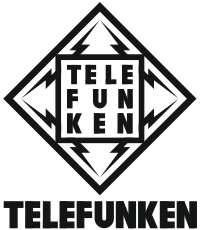Telefunken

Telefunken logo. It also appears in red, and also as brown, red/orange segments and blue lettering.
|
|
| Industry | Electrical industry |
|---|---|
| Founded | 1903 |
| Defunct | 1967 merger with parent company AEG to AEG-Telefunken (1996 merger with Daimler-Benz and sale/dissolution various company parts), 2005 rename of the last former Telefunken division |
| Headquarters | Germany |
| Website |
www |
Telefunken was a German radio and television apparatus company, founded in Berlin in 1903, as a joint venture of Siemens & Halske and the Allgemeine Elektricitäts-Gesellschaft (AEG) (General electricity company).
The name "Telefunken" appears in:
The company Telefunken USA was incorporated in early 2001 to provide restoration services and build reproductions of vintage Telefunken microphones.
Around the start of the 20th century, two groups of German researchers worked on the development of techniques for wireless communication. The one group at AEG, led by Adolf Slaby and Georg Graf von Arco, developed systems for the Kaiserliche Marine; the other one, under Karl Ferdinand Braun, at Siemens, for the German Army. Their main competitor was the British Marconi Company.
When a dispute concerning patents arose between the two companies, Kaiser Wilhelm II urged both parties to join efforts, creating Gesellschaft für drahtlose Telegraphie System Telefunken ("The Company for Wireless Telegraphy Ltd.") joint venture on 27 May 1903, with the disputed patents and techniques invested in it. On 17 April 1923, it was renamed Telefunken, The Company for Wireless Telegraphy. Telefunken was the company's telegraph address. The first technical director of Telefunken was Count Georg von Arco.
Telefunken rapidly became a major player in the radio and electronics fields, both civilian and military. During World War I, they supplied radio sets and telegraphy equipment for the military, as well as building one of the first radio navigation systems for the Zeppelin force. The Telefunken Kompass Sender operated from 1908 to 1918, allowing the Zeppelins to navigate throughout the North Sea area in any weather.
Starting in 1923, Telefunken built broadcast transmitters and radio sets. In 1928, Telefunken made history by designing the V-41 amplifier for the German Radio Network. This was the very first two-stage, "Hi-Fi" amplifier. Over time, Telefunken perfected their designs and in 1950 the V-72 amplifier was developed. The TAB (a manufacturing subcontractor to Telefunken) V-72 soon became popular with other radio stations and recording facilities. The V-72S was the only type of amplifier found in the REDD.37 console used by the Beatles at Abbey Road Studios on many of their early recordings. In 1932, record players were added to the product line.
...
Wikipedia
